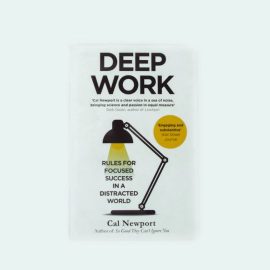

This article is an excerpt from the Shortform book guide to "Business Made Simple" by Donald Miller. Shortform has the world's best summaries and analyses of books you should be reading.
Like this article? Sign up for a free trial here.
Looking for examples of adding value to a company? How and why should employees add value to a company?
In Business Made Simple, author and business expert Donald Miller describes why adding value to a company (not just doing the bare minimum) is the best way to lead a successful career. In the book, Miller offers several actionable examples of adding value to a company.
Read on for three examples of adding value to a company, according to Business Made Simple.
Adding Value to a Company
What are some examples of adding value to a company? According to business and marketing expert Donald Miller, successful professionals view themselves as entities that can provide value to a company (rather than merely as employees). He believes it’s important to learn how to quantify and explain what value you add—for instance, how many sales you made last year and what revenue those brought in.
In Miller’s book Business Made Simple, he offers more examples of adding value to a company to demonstrate that you are a good investment to your employer. In this article, we’ll describe three examples of how to add value to your company.
#1: Develop Value-Adding Character Traits
According to Miller, to become a good investment and add value to your company, you should develop and demonstrate strength of character. Some examples of the traits of a strong, value-driven character include:
- Prioritizing Being Respected Over Being Liked. When you become a manager, it’s more important for the success of the company and team that others trust you rather than like you. Earn trust by setting clear goals, ensuring everyone knows their individual responsibilities, and rewarding them when they fulfill those goals and responsibilities.
(Shortform note: In The Success Principles, Jack Canfield adds another, perhaps less appealing, way to maintain your team’s trust: by taking responsibility for bad outcomes that were the result of your decisions. While owning up to mistakes may sound unpleasant, in the long term, it’s better for you and the team because you avoid sowing distrust by deflecting responsibility.)
- Being Action-Oriented. You habitually see projects through to completion, understanding that it’s not enough to intend or plan to do something: You must actually do it.
- Trusting That You Know What to Do. When you trust and act on your knowledge, you advance faster than if you procrastinate or feign confusion to avoid a difficult decision.
(Shortform note: The two above traits are psychologically related: When you trust that you know what to do and that you can execute tasks—a concept referred to in psychology as self-efficacy—you tend to be more action-oriented. What’s more, you’re more likely to bounce back from setbacks, a trait we might imagine being well-placed on this list.)
- Being Overwhelmingly Positive. Feeling optimistic about the outcomes of your actions means you take more risks, which means you reap greater rewards in the long run.
- Believing You Can Improve. When you believe in your capacity to get better, you don’t give up after a failure, seeing it instead as a growth opportunity. You also take on greater challenges because you believe you can rise to meet them. The result of this is that you do grow and improve, which leads to more responsibility and higher pay.
(Shortform note: In The Happiness Advantage, Shawn Achor contends that the above traits of positivity and belief in your ability to improve are especially important in difficult situations. He describes the three responses you can have to a problem: to keep mulling it over and accomplish nothing, to exacerbate the problem through another bad decision, or to take the opportunity to grow and improve. Only when you believe you can improve as a result of adversity will you have the third response and grow.)
#2: Manage Teams Effectively Using Metrics
Let’s now turn to the effective management of people, another example of adding value to a company, according to Miller. He contends that a value-driven manager relies on input and output metrics as their guiding light because these indicate concretely what they’re doing well and what they could be doing better. An input metric (what Miller refers to as a lead indicator) is a measure of how much work goes into producing an output. An output metric (what Miller calls a lag indicator) is a measure of how much output was produced by the input.
For instance, three weekly social media posts (input metric) lead to 300 new followers through your social media page (output metric).
Use these metrics to make decisions that increase the value your department adds to the company. For instance, you might decide that relative to competitors, accruing 300 followers a week isn’t enough, and you might then increase the input metric to garner more followers.
| Avoid Tracking “Vanity” Metrics While tracking metrics is a common and accepted facet of growing a business, it’s critical that you track the right metrics. In The Lean Startup, Eric Ries warns against tracking “vanity metrics”: metrics that make the picture of your company look rosy but don’t actually reflect positive change. Such vanity metrics are numbers that always increase, without intervention on your part. This could be the number of social media posts you make a year: By the end of the year, you might have 300 more social media posts than you had at the start of the year, which you might perceive as a success. But if you’ve simply consistently produced six posts a week all year, those 300 new posts don’t indicate progress. They just indicate you’ve been doing things the same as last year. Conversely, if you were to track the rate at which you produce posts, you’d see the rate was stagnant at six posts a week, and you could decide to increase that rate. Often, the right metrics to track are input metrics because these reflect what you’re doing on a daily or weekly basis and are more within your control to change. Tracking only vanity metrics keeps you from making important changes to your business because they give you the false impression you’re doing everything perfectly already. |
#3: Enhance Productivity by Focusing Only on Critical Tasks
One of Miller’s final examples of adding value to a company is to manage your time to get the most value out of every hour. According to Miller, the best way to do this is to prioritize the tasks that give you the highest return on your investment of energy. Then, delegate or eliminate the other tasks.
Miller says you can best prioritize by creating two task lists: one that contains the three most important things to get done today and another one that contains all other, less important tasks. Then, get the three key tasks done first (or at least a piece of each key task, if they’re big).
(Shortform note: If Miller’s advice to create two task lists to aid prioritization isn’t detailed enough for your needs, you might follow some of David Allen’s advice in Getting Things Done. You could sub-organize your non-critical task list into tasks you’re waiting for additional input on, tasks you want to do at some point, and tasks you’ll need to address in the future. You could also sub-organize important tasks into task types—like personal tasks, delegated tasks, and so on. This might further help you determine which tasks give you the highest return on your time investment.)

———End of Preview———
Like what you just read? Read the rest of the world's best book summary and analysis of Donald Miller's "Business Made Simple" at Shortform.
Here's what you'll find in our full Business Made Simple summary:
- Why you aren’t making as much progress in your career as you’d like
- Why you should see yourself as an investment of your organization
- 11 steps to add value to yourself as an employee






